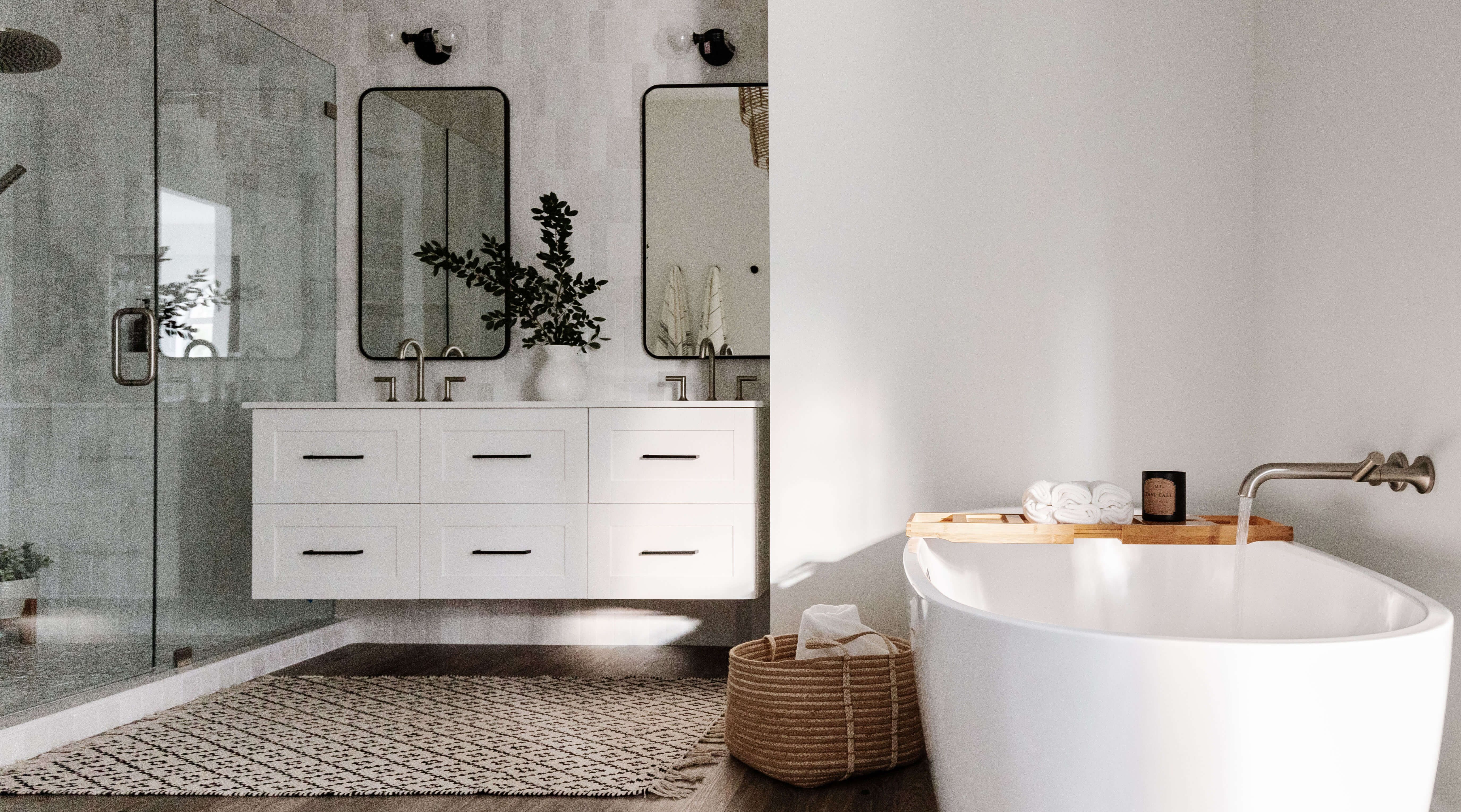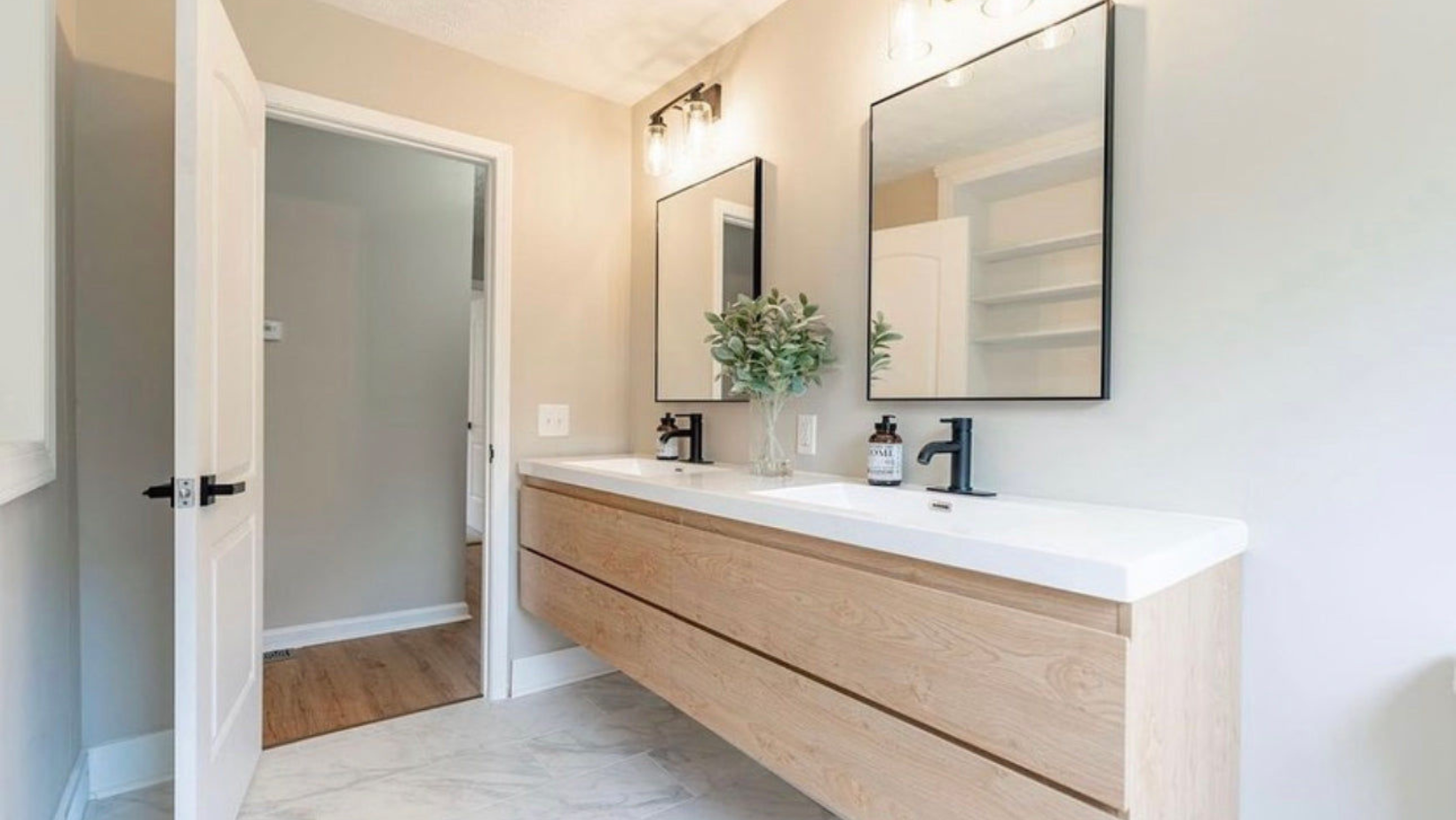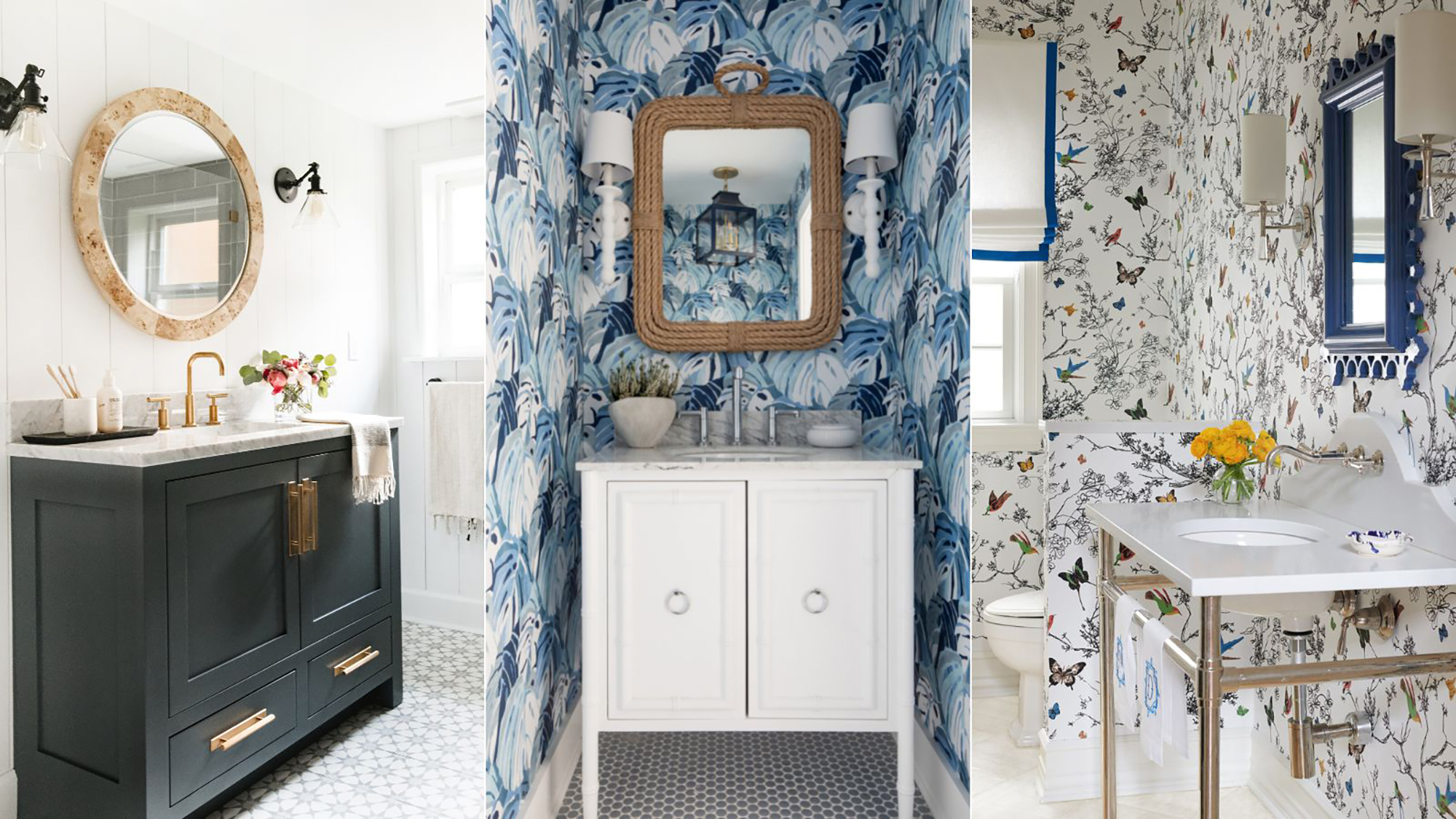Off-the-Floor Bathroom Vanity Styles and Designs: Off The Floor Bathroom Vanity

Off-the-floor bathroom vanities, also known as floating vanities, have become increasingly popular in recent years, adding a touch of modern elegance to any bathroom. They’re a stylish and practical choice, offering a sleek, uncluttered look while maximizing space.
Vanity Styles
The style of your off-the-floor vanity should complement the overall design of your bathroom. Here’s a breakdown of some popular styles:
- Modern: Modern vanities are characterized by clean lines, minimalist designs, and a focus on functionality. They often feature sleek, geometric shapes, metallic accents, and high-gloss finishes. Think of a sleek, chrome-trimmed cabinet with a rectangular, integrated sink.
- Traditional: Traditional vanities embrace classic design elements, such as intricate carvings, ornate hardware, and warm wood tones. They often have a more elaborate and detailed aesthetic, featuring pedestal-like bases or carved legs. Think of a vanity with a curved, wood-grain cabinet, ornate legs, and a porcelain sink.
- Farmhouse: Farmhouse vanities are inspired by the rustic charm of rural living. They typically feature distressed wood finishes, open shelving, and simple hardware. They often have a warm, inviting feel, with natural materials like wood and metal. Think of a vanity with reclaimed wood, a distressed finish, and a farmhouse-style sink.
- Contemporary: Contemporary vanities are a blend of modern and traditional elements, offering a sleek and stylish look while incorporating classic design principles. They often feature clean lines, natural materials, and a focus on functionality. Think of a vanity with a combination of wood and metal, sleek lines, and a minimalist design.
Materials
Off-the-floor vanities are crafted from a variety of materials, each with its own unique look and feel.
- Wood: Wood is a popular choice for off-the-floor vanities, offering durability, warmth, and natural beauty. Popular wood types include oak, maple, cherry, and walnut. Think of a vanity made from solid oak with a natural finish.
- Metal: Metal vanities provide a sleek, modern look, often incorporating stainless steel, chrome, or brass accents. They’re durable and easy to clean, making them a practical choice. Think of a vanity with a stainless steel frame and a glass countertop.
- Stone: Stone vanities, such as granite or marble, offer a luxurious and sophisticated look. They’re also very durable and resistant to scratches and stains. Think of a vanity with a granite countertop and a marble basin.
Design Features
Off-the-floor vanities offer a range of unique design features that enhance their functionality and aesthetic appeal.
- Open Shelving: Open shelving provides a stylish and functional way to display toiletries and decorative items. It also helps to create a sense of openness and airiness in the bathroom. Think of a vanity with open shelves on either side of the sink.
- Floating Cabinets: Floating cabinets give the illusion of a spacious and uncluttered bathroom. They’re also a great way to maximize storage space. Think of a vanity with a floating cabinet that appears to be suspended in mid-air.
- Integrated Sinks: Integrated sinks are seamlessly integrated into the countertop, creating a sleek and modern look. They’re also easier to clean than traditional sinks. Think of a vanity with a countertop that slopes gently down to form a sink.
Pros and Cons of Off-the-Floor Vanities
| Style | Pros | Cons |
|---|---|---|
| Modern | Sleek and contemporary, maximizes space, easy to clean | May not be suitable for traditional bathrooms, can be expensive |
| Traditional | Elegant and timeless, adds warmth and character, durable | Can be more expensive than other styles, may require more maintenance |
| Farmhouse | Rustic charm, adds warmth and personality, often affordable | May not be suitable for modern bathrooms, can be prone to scratches |
| Contemporary | Stylish and versatile, combines modern and traditional elements, functional | May be more expensive than other styles, can be difficult to find |
Advantages and Disadvantages of Off-the-Floor Bathroom Vanities

Off-the-floor bathroom vanities, also known as floating vanities, are a popular choice for modern bathrooms. They offer a sleek, contemporary look and can make a small bathroom feel more spacious. But before you jump on the floating vanity bandwagon, it’s important to weigh the pros and cons.
Advantages of Off-the-Floor Bathroom Vanities
Off-the-floor vanities offer several advantages over traditional floor-mounted vanities. Here are some of the key benefits:
- Easy to Clean: One of the biggest advantages of off-the-floor vanities is that they’re incredibly easy to clean. With no base to worry about, you can easily sweep or mop under the vanity without having to move anything. No more dust bunnies hiding under your bathroom furniture!
- Increased Storage Space: Off-the-floor vanities often have more storage space than traditional vanities. This is because the base is not taking up any space, allowing for larger drawers or cabinets. You can finally say goodbye to clutter and keep your bathroom organized.
- Modern Aesthetic: Off-the-floor vanities have a sleek and modern look that can instantly upgrade your bathroom. They’re a great way to create a contemporary and stylish space, especially if you’re going for a minimalist aesthetic.
Disadvantages of Off-the-Floor Bathroom Vanities
While off-the-floor vanities have their advantages, they also come with some drawbacks.
- Higher Cost: Off-the-floor vanities are generally more expensive than traditional vanities. This is because they require more complex construction and often use higher-quality materials. But hey, you get what you pay for, right?
- Potential Instability: Off-the-floor vanities can be less stable than traditional vanities, especially if they are not properly installed. If the wall is not strong enough to support the weight of the vanity, it could collapse. This is why it’s crucial to hire a qualified contractor for installation.
- Limited Countertop Options: Off-the-floor vanities may have limited countertop options compared to traditional vanities. This is because the countertop must be able to support the weight of the sink and other fixtures without sagging. But fear not, there are still plenty of stylish and durable countertop options available for off-the-floor vanities.
Selecting the Right Off-the-Floor Vanity for Your Bathroom
Choosing the right off-the-floor vanity for your bathroom depends on your individual needs and preferences. Here are some tips:
- Bathroom Size: Consider the size of your bathroom. Off-the-floor vanities can make a small bathroom feel more spacious, but they can also make a large bathroom feel cramped if they are not the right size.
- Layout: Think about the layout of your bathroom. Off-the-floor vanities can be difficult to install in bathrooms with awkward corners or limited wall space.
- Style: Choose a vanity that complements the overall style of your bathroom. Off-the-floor vanities come in a wide range of styles, from modern to traditional.
Common Concerns About Off-the-Floor Vanities and Solutions
Here are some common concerns about off-the-floor vanities and solutions:
- Water Damage: One concern is water damage. If the vanity is not properly sealed, water can leak behind it and damage the wall. The solution is to ensure the vanity is properly sealed and installed.
- Plumbing: Another concern is plumbing. Off-the-floor vanities require special plumbing fixtures that are designed to be installed on a wall. The solution is to consult with a qualified plumber before installing an off-the-floor vanity.
- Weight: Some people are concerned about the weight of off-the-floor vanities. They worry that the vanity will be too heavy for the wall to support. The solution is to choose a vanity that is made from lightweight materials and to ensure that the wall is strong enough to support the weight.
Installation and Maintenance of Off-the-Floor Bathroom Vanities

Installing and maintaining an off-the-floor bathroom vanity is a breeze, especially if you’re not afraid of a little DIY. It’s all about preparation, precision, and a healthy dose of patience.
Installing an Off-the-Floor Bathroom Vanity
Installing an off-the-floor bathroom vanity is a bit like building a miniature house for your sink. You need to prepare the foundation, mount the walls, and connect the utilities. Let’s break it down step-by-step:
- Prepare the Wall: The first step is to make sure the wall is ready for its new resident. This involves checking for studs, leveling the surface, and patching up any imperfections. You want your vanity to be as sturdy as a rock, so make sure it’s anchored properly.
- Mount the Vanity: Once the wall is prepped, you can mount the vanity. This usually involves attaching brackets to the wall and then securing the vanity to those brackets. Remember, a little extra support never hurts, so consider using wall anchors if necessary.
- Connect the Plumbing: This is where things get a little more technical. You’ll need to connect the vanity’s drain to the main drain line and the water supply lines to the faucet. This involves using P-traps, shut-off valves, and a whole lot of plumbing tape. Don’t worry, it’s not as complicated as it sounds. Just follow the instructions carefully and you’ll be golden.
Maintaining an Off-the-Floor Bathroom Vanity, Off the floor bathroom vanity
Maintaining your off-the-floor bathroom vanity is like taking care of a beloved pet. You need to keep it clean, feed it (with cleaning supplies), and address any issues that may arise.
- Cleaning and Sealing Surfaces: Regular cleaning is crucial for keeping your vanity looking its best. This involves wiping down the surfaces with a damp cloth and using a mild cleaner. If you have a stone countertop, be sure to seal it periodically to prevent stains.
- Replacing Hardware: Over time, the hardware on your vanity may start to show signs of wear and tear. This includes things like knobs, handles, and hinges. Don’t worry, replacing these parts is a simple fix. Just head to your local hardware store and pick up some replacements.
- Addressing Potential Issues: Even the most well-maintained vanities can encounter problems. This could include leaky faucets, clogged drains, or loose brackets. Don’t let these issues linger. Address them promptly to prevent further damage.
Tips for Preventing Damage to Off-the-Floor Vanities
Preventing damage to your off-the-floor vanity is all about using common sense and a little extra care. Here are a few tips to keep in mind:
- Avoid Excessive Weight: Your vanity is not a storage unit for your entire bathroom collection. Avoid overloading it with heavy items, as this can put stress on the brackets and cause damage.
- Use Appropriate Cleaning Products: Not all cleaning products are created equal. Some can damage the finish of your vanity. Always use mild cleaners and avoid abrasive materials.
Essential Tools and Materials for Installing and Maintaining an Off-the-Floor Bathroom Vanity
Before you dive into the world of off-the-floor vanity installation and maintenance, make sure you have the right tools and materials. This will make the process much smoother and less stressful.
- Tools:
- Screwdriver
- Drill
- Level
- Measuring tape
- Wrench
- Pliers
- Utility knife
- Materials:
- Wall anchors
- Screws
- Plumbing tape
- Caulking
- Cleaning supplies
- Sealant (for stone countertops)
